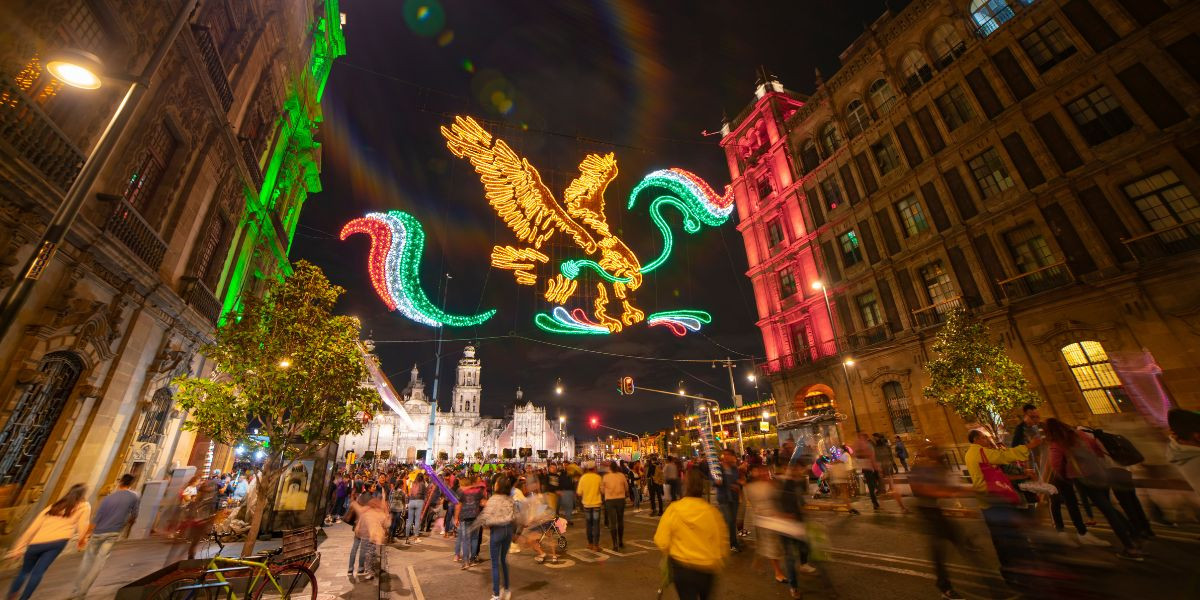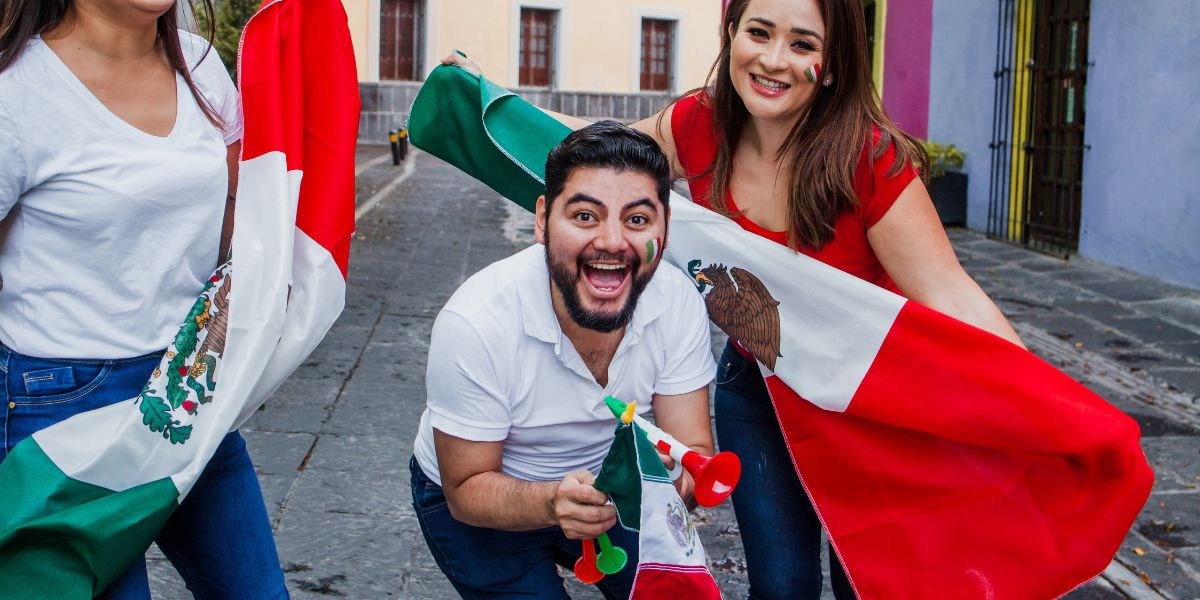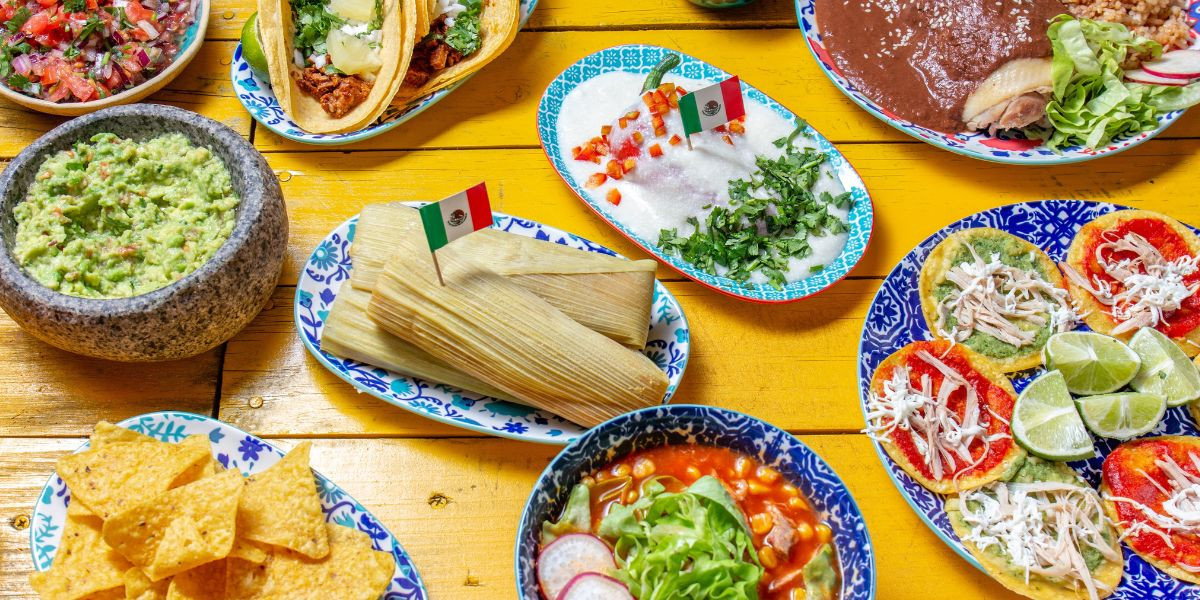Mexican Independence Day is a vibrant celebration of national pride and heritage, and at gaymexico.net, we want to guide you through the festivities, especially if you’re planning a visit or want to connect with your Mexican roots. This holiday, observed with spirited parades, delicious food, and enthusiastic reenactments, offers a unique opportunity to immerse yourself in Mexican culture. Learn about the traditions, events, and destinations that make this holiday special, enhancing your understanding and appreciation of Mexican heritage with gay pride events, LGBTQ+ celebrations, and inclusive tourism insights.
1. What Is The Story Behind Mexican Independence Day?
Mexican Independence Day commemorates the beginning of the country’s fight for independence from Spanish rule. The spark that ignited the revolution was “El Grito de Dolores,” or the Cry of Dolores, on September 16, 1810, when Miguel Hidalgo y Costilla, a priest, rallied the people to rise up against the colonial government. Every year, this pivotal moment is honored through reenactments and celebrations that highlight Mexican unity and patriotism.
1.1. When Is “El Grito de Dolores” Reenacted?
“El Grito de Dolores” is reenacted every year on the evening of September 15th at 11:00 P.M. The President of Mexico performs the reenactment from the balcony of the National Palace in Mexico City, echoing Hidalgo’s original call to arms. The President shouts, “¡Viva México!” to a crowd gathered in the Zócalo below, sparking a night of national celebration, fireworks, and festivities nationwide. This tradition reinforces national identity and commemorates the country’s long struggle for freedom.
 President of Mexico reenacting El Grito de Dolores
President of Mexico reenacting El Grito de Dolores
1.2. What Does The Reenactment Symbolize?
The reenactment of “El Grito de Dolores” symbolizes the unity, pride, and enduring spirit of independence of the Mexican people. It serves as a reminder of the courage and sacrifices made by those who fought for Mexico’s freedom. This reenactment not only commemorates a historical event but also strengthens the collective identity and patriotism of Mexicans across the country and beyond.
1.3. How Does This Date Celebrate Mexican Identity?
This date celebrates Mexican identity by honoring the courage and determination of the leaders and citizens who fought for freedom. It symbolizes the unity of the Mexican people in their pursuit of self-determination and justice. The holiday also promotes cultural pride, as people celebrate with traditional music, dance, food, and attire, reflecting the rich heritage of Mexico.
2. How Is Mexican Independence Day Celebrated In Mexico?
Mexican Independence Day is celebrated with colorful parades, historical reenactments, and lively music. Cities and towns across Mexico come alive with decorations, traditional attire, and the aroma of festive foods. These celebrations reflect the country’s rich culture, history, and the spirited essence of its people.
2.1. What Role Do Parades Play In The Celebrations?
Parades on Mexican Independence Day showcase the nation’s rich culture and history. They feature floats decorated with patriotic symbols, dancers in traditional attire, and vibrant music, creating a lively and unified atmosphere. These parades highlight the pride of the Mexican people and their shared heritage. The parades also serve as an educational tool, teaching younger generations about the historical events and figures that shaped their nation.
2.2. What Is The Significance Of Mariachi Music?
Mariachi music fills the air around the Angel of Independence and other public spaces, adding to the festive atmosphere. People sing along to traditional songs like “Cielito Lindo,” uniting all generations in a bond of patriotism and national pride. Mariachi music, with its distinctive instrumentation and passionate vocals, is an integral part of Mexican culture and a symbol of national identity.
2.3. What Traditional Foods Are Eaten During The Celebrations?
Traditional Mexican foods such as pozole, enchiladas, tostadas, and gorditas are popular during the Independence Day celebrations. These dishes are enjoyed in homes, restaurants, and street fairs, adding to the joyful spirit of the holiday. Each dish represents a piece of Mexico’s culinary heritage, with recipes passed down through generations.
 Traditional Mexican Food
Traditional Mexican Food
3. What Are The Key Events During The Two-Day Mexican Independence Day Celebration?
The two-day Mexican Independence Day celebration is packed with key events, including historical reenactments, vibrant parades, and mesmerizing pyrotechnic displays, all reflecting the spirited essence of Mexico. The celebrations offer a deep dive into Mexican culture, history, and national pride.
3.1. Where Can You Experience Historical Reenactments?
Historical reenactments take place in various public squares and schools across Mexico on the morning of September 16th. These reenactments depict key moments from the Mexican War of Independence, educating and entertaining audiences of all ages. Participants often dress in period costumes, bringing history to life and fostering a sense of connection to the past.
3.2. What Types Of Pyrotechnic Displays Are Common?
Pyrotechnic displays are a highlight of Mexican Independence Day celebrations, with fireworks lighting up the night sky in cities and towns across the country. These displays often accompany the reenactment of “El Grito de Dolores,” adding to the festive and patriotic atmosphere. The vibrant colors and patterns of the fireworks symbolize the country’s vibrant culture and the bright future of its people.
3.3. How Do The Celebrations Reflect The Essence Of Mexico?
The celebrations reflect the essence of Mexico through the display of national symbols, traditional music, dance, and cuisine. The joyful spirit and unity of the people during these festivities showcase the country’s strong sense of identity and pride. The combination of historical reflection, cultural expression, and communal celebration embodies the heart and soul of Mexico.
4. How Can LGBTQ+ Individuals Celebrate Mexican Independence Day?
LGBTQ+ individuals can celebrate Mexican Independence Day by participating in the national festivities and finding spaces that promote inclusivity and pride. Many cities with large LGBTQ+ communities host special events that blend national pride with LGBTQ+ culture. This allows for a unique and affirming way to celebrate both Mexican heritage and LGBTQ+ identity.
4.1. Are There Specific LGBTQ+ Events During This Time?
While not all events are exclusively LGBTQ+, many cities known for their LGBTQ+ communities, such as Mexico City and Puerto Vallarta, often host inclusive parties and gatherings during the Independence Day period. These events provide a safe and celebratory space for LGBTQ+ individuals to express their pride and connect with others. Check local listings on gaymexico.net for up-to-date information on specific events.
4.2. How Can LGBTQ+ Visitors Ensure A Safe And Welcoming Experience?
LGBTQ+ visitors can ensure a safe and welcoming experience by researching LGBTQ+-friendly venues and areas in advance. Cities like Puerto Vallarta and Mexico City have established LGBTQ+ scenes and offer a variety of welcoming establishments. Additionally, staying informed about local laws and customs can help ensure a respectful and enjoyable visit.
4.3. What Resources Are Available For LGBTQ+ Travelers On gaymexico.net?
Gaymexico.net provides resources for LGBTQ+ travelers, including guides to LGBTQ+-friendly destinations, listings of gay bars and clubs, and information on local LGBTQ+ organizations. These resources help travelers plan their trips with confidence and connect with the LGBTQ+ community in Mexico. The website aims to offer a comprehensive and inclusive view of Mexico, catering to the diverse interests and needs of LGBTQ+ visitors.
5. What Are Some Lesser-Known Traditions Associated With Mexican Independence Day?
Beyond the well-known parades and reenactments, several lesser-known traditions enrich the celebration of Mexican Independence Day. These include regional variations in food, music, and dress, reflecting the diversity of Mexican culture. Exploring these traditions offers a deeper appreciation for the holiday’s significance.
5.1. Are There Regional Variations In How The Day Is Celebrated?
Yes, regional variations in celebrating Mexican Independence Day are abundant. For instance, certain towns may emphasize specific historical figures or local heroes in their reenactments. Culinary traditions also vary, with each region boasting unique dishes that are prepared and enjoyed during the festivities. Music and dance styles also differ, showcasing the diverse cultural tapestry of Mexico.
5.2. How Do Families Typically Celebrate At Home?
Families often celebrate at home by hosting parties with traditional Mexican food, music, and decorations. They may also watch the reenactment of “El Grito de Dolores” on television and participate in local community events. These home celebrations strengthen family bonds and instill a sense of national pride in younger generations.
5.3. What Are Some Unique Cultural Performances To Watch Out For?
Unique cultural performances during Mexican Independence Day celebrations include traditional dances such as the “Jarabe Tapatío” (the Mexican hat dance) and performances by regional music groups. These performances showcase the rich artistic heritage of Mexico and provide entertainment for audiences of all ages. Keep an eye out for local theater groups that may stage historical plays or reenactments as well.
6. What Travel Tips Should Visitors Keep In Mind During Mexican Independence Day?
Visitors should keep in mind that Mexican Independence Day is a peak travel period, so it is essential to book accommodations and transportation in advance. Be prepared for large crowds and potential traffic delays, especially in major cities. Also, take advantage of the opportunity to immerse yourself in the local culture and traditions, but always be respectful of local customs.
6.1. How Far In Advance Should Accommodation And Travel Be Booked?
Accommodation and travel should be booked several months in advance, especially if you plan to visit popular destinations like Mexico City, Puerto Vallarta, or Cancun. Booking early ensures you have a wider selection of options and can often secure better prices. Last-minute bookings can be challenging and may result in higher costs or limited availability.
6.2. What Safety Precautions Should Be Taken During Large Public Gatherings?
Safety precautions during large public gatherings include staying aware of your surroundings, keeping valuables secure, and avoiding isolated areas. It is also advisable to travel in groups and to be mindful of alcohol consumption. In case of an emergency, know the location of emergency exits and follow the instructions of local authorities.
6.3. Are There Any Specific Customs Or Etiquette To Be Aware Of?
Specific customs and etiquette to be aware of include showing respect for national symbols, such as the Mexican flag and national anthem. When attending public events, dress modestly and be mindful of noise levels. It is also polite to learn a few basic Spanish phrases to communicate with locals. Tipping is customary in restaurants and for certain services.
 Celebrations of Mexican Independence Day
Celebrations of Mexican Independence Day
7. How Does The Celebration of Mexican Independence Day Differ From Cinco De Mayo?
The celebration of Mexican Independence Day, on September 16th, is often confused with Cinco de Mayo, which commemorates the Mexican army’s victory over French forces at the Battle of Puebla on May 5, 1862. Mexican Independence Day marks the start of Mexico’s fight for independence from Spain, making it a more significant national holiday within Mexico itself. While Cinco de Mayo is more widely celebrated in the United States, Mexican Independence Day holds deeper historical and cultural importance in Mexico.
7.1. What Is The Historical Significance Of Each Holiday?
Mexican Independence Day commemorates Miguel Hidalgo’s “Grito de Dolores” on September 16, 1810, which initiated the Mexican War of Independence. Cinco de Mayo, on the other hand, celebrates the Mexican army’s victory at the Battle of Puebla in 1862 during the French intervention in Mexico. Mexican Independence Day is a celebration of the country’s sovereignty, while Cinco de Mayo commemorates a specific military victory.
7.2. How Are These Holidays Celebrated In Mexico Vs. The United States?
In Mexico, Mexican Independence Day is celebrated with great national pride, featuring parades, reenactments, fireworks, and traditional festivities. Cinco de Mayo is observed with smaller celebrations, mainly in Puebla and other specific regions. In the United States, Cinco de Mayo has become a broader celebration of Mexican culture, often marked by parades, festivals, and parties that highlight Mexican food, music, and traditions.
7.3. Why Is Cinco De Mayo More Popular In The U.S. Than In Mexico?
Cinco de Mayo is more popular in the U.S. due to its adoption as a celebration of Mexican-American culture and heritage. It has been promoted by marketing efforts and community events, becoming a day for people of all backgrounds to appreciate Mexican contributions to American society. In contrast, Mexican Independence Day remains primarily a Mexican national holiday with deep historical and cultural significance within Mexico.
8. What Impact Does Mexican Independence Day Have On Tourism?
Mexican Independence Day significantly boosts tourism, both domestic and international. Many tourists visit Mexico to experience the vibrant celebrations and immerse themselves in the country’s culture and history. The holiday also provides an opportunity for Mexican expatriates to return home and reconnect with their roots.
8.1. How Does The Holiday Affect Hotel Occupancy Rates?
Hotel occupancy rates typically increase during Mexican Independence Day, especially in popular tourist destinations and cities hosting major celebrations. Hotels often offer special packages and events to attract visitors, contributing to higher occupancy and revenue. Booking accommodations well in advance is advisable due to increased demand.
8.2. Are There Special Tourism Packages Available During This Time?
Yes, many tourism companies offer special packages for Mexican Independence Day, including tours of historical sites, tickets to cultural events, and accommodations in festive hotels. These packages cater to both domestic and international tourists, providing convenient and comprehensive ways to experience the holiday. Look for deals on gaymexico.net to enhance your travel experience.
8.3. What Opportunities Are There For Cultural Immersion For Tourists?
Mexican Independence Day offers numerous opportunities for cultural immersion, such as attending local parades and reenactments, sampling traditional cuisine at street fairs, and participating in community celebrations. Tourists can also visit museums and historical sites to learn more about Mexico’s struggle for independence. Engaging with local communities and participating in traditional activities provides a deeper understanding of Mexican culture and heritage.
9. How Is Social Media Used To Share And Celebrate Mexican Independence Day?
Social media platforms play a significant role in sharing and celebrating Mexican Independence Day. People use social media to post photos and videos of celebrations, share messages of national pride, and connect with friends and family. Social media also serves as a tool for promoting events and raising awareness about the holiday’s historical significance.
9.1. What Are Some Common Hashtags Used During The Celebrations?
Common hashtags used during Mexican Independence Day celebrations include #VivaMexico, #MexicoIndependiente, #GritoDeDolores, and #FiestasPatrias. These hashtags help users find and share content related to the holiday, creating a virtual community of celebrants. They also provide a way to track trending topics and see how people are celebrating across different regions.
9.2. How Do People Share Their Experiences Online?
People share their experiences online through photos, videos, and live streams of parades, fireworks, and cultural performances. They also post personal messages of patriotism and share stories about their family traditions. Social media platforms become virtual spaces for people to express their love for Mexico and connect with others who share their pride.
9.3. How Do Businesses And Organizations Utilize Social Media During This Time?
Businesses and organizations utilize social media to promote their products and services, sponsor events, and engage with their audiences. They may offer special discounts or promotions for Mexican Independence Day and create content that highlights Mexican culture and heritage. Social media campaigns during this time aim to build brand loyalty and connect with customers on an emotional level.
10. What Is The Future Of Mexican Independence Day Celebrations?
The future of Mexican Independence Day celebrations is likely to see a continued blend of traditional customs with modern expressions of national pride. As technology evolves, social media and digital platforms will play an even greater role in sharing and promoting the holiday. Efforts to make celebrations more inclusive and accessible to all members of society, including LGBTQ+ individuals, are also expected to grow.
10.1. How Might Technology Change The Way The Holiday Is Celebrated?
Technology may change the way Mexican Independence Day is celebrated through virtual reality experiences, online streaming of events, and interactive social media campaigns. Virtual reality could allow people to experience the “Grito de Dolores” from anywhere in the world, while online streaming could bring parades and cultural performances to a global audience. Interactive social media campaigns could encourage greater participation and engagement.
10.2. What Efforts Are Being Made To Make The Celebrations More Inclusive?
Efforts are being made to make the celebrations more inclusive by promoting diversity and representation in parades and cultural performances. LGBTQ+ organizations are working to create safe and welcoming spaces for LGBTQ+ individuals to participate in the festivities. Additionally, there is a growing emphasis on educating people about the historical contributions of diverse groups to Mexico’s independence.
10.3. How Can Future Generations Connect With The Holiday’s Significance?
Future generations can connect with the holiday’s significance through educational programs, community events, and family traditions. Schools can teach students about the history of Mexican Independence Day and encourage them to participate in reenactments and cultural performances. Families can pass down stories and traditions, fostering a sense of national pride and cultural identity. Engaging with the holiday through personal and meaningful ways ensures that its significance is preserved for future generations.
Mexican Independence Day is more than just a holiday; it’s a vibrant expression of Mexican identity, history, and culture. Whether you’re planning a trip to experience the festivities firsthand or looking to connect with your heritage, we at gaymexico.net are here to guide you. We invite you to explore our website for detailed travel guides, event listings, and resources tailored to the LGBTQ+ community. Discover the beauty and diversity of Mexico with us, and join in celebrating the spirit of independence! Visit gaymexico.net today, your address is 3255 Wilshire Blvd, Los Angeles, CA 90010, United States, or give us a call +1 (213) 380-2177.
FAQ: Mexican Independence Day Celebrations
1. What is Mexican Independence Day?
Mexican Independence Day commemorates the start of Mexico’s fight for independence from Spain, initiated by Miguel Hidalgo’s “Grito de Dolores” on September 16, 1810. It celebrates national pride, unity, and the country’s rich history and culture.
2. When is Mexican Independence Day celebrated?
Mexican Independence Day is celebrated on September 16th each year, with festivities often beginning on the evening of September 15th.
3. Where is Mexican Independence Day celebrated?
Mexican Independence Day is celebrated throughout Mexico and in Mexican communities worldwide. Major celebrations occur in Mexico City, but cities and towns across the country host their own festivities.
4. Who celebrates Mexican Independence Day?
Mexican Independence Day is celebrated by Mexicans of all ages and backgrounds, as well as those who appreciate Mexican culture and heritage. It is a time for families, communities, and the nation to come together in unity and pride.
5. Why is Mexican Independence Day important?
Mexican Independence Day is important because it marks the beginning of Mexico’s journey to sovereignty and freedom from Spanish colonial rule. It honors the courage and sacrifices of those who fought for independence and symbolizes the country’s identity and cultural heritage.
6. How is Mexican Independence Day different from Cinco de Mayo?
Mexican Independence Day celebrates the start of Mexico’s fight for independence, while Cinco de Mayo commemorates a specific battle victory against French forces. Mexican Independence Day is a more significant national holiday in Mexico, whereas Cinco de Mayo is more widely celebrated in the United States.
7. Are there LGBTQ+ events during Mexican Independence Day?
While not always exclusive, cities with large LGBTQ+ communities, like Mexico City and Puerto Vallarta, often host inclusive parties and gatherings during the Independence Day period, providing safe and celebratory spaces for LGBTQ+ individuals.
8. What are some traditional foods eaten during Mexican Independence Day celebrations?
Traditional Mexican foods such as pozole, enchiladas, tostadas, and gorditas are popular during the Independence Day celebrations, enjoyed in homes, restaurants, and street fairs across the country.
9. What travel tips should visitors keep in mind during Mexican Independence Day?
Visitors should book accommodations and transportation well in advance due to high demand. Be prepared for large crowds and traffic delays, and take safety precautions during public gatherings. Also, be respectful of local customs and traditions.
10. How can future generations connect with the significance of Mexican Independence Day?
Future generations can connect with the holiday’s significance through educational programs, community events, and family traditions. Schools can teach students about the history, and families can pass down stories and customs, fostering a sense of national pride and cultural identity.
